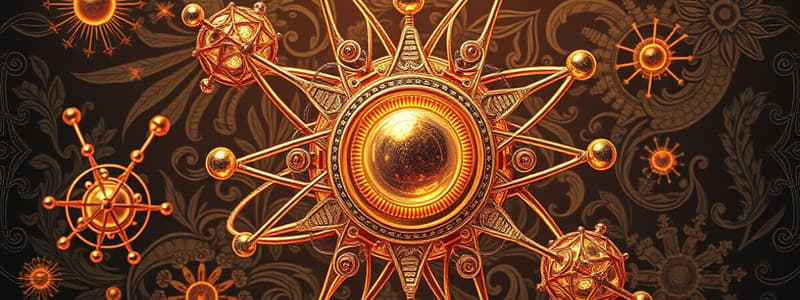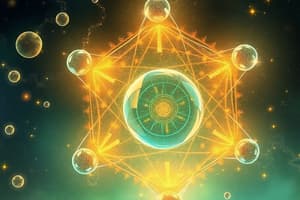Podcast
Questions and Answers
Who were the first philosophers to introduce the concept of atoms?
Who were the first philosophers to introduce the concept of atoms?
- Democritus and Leucippus (correct)
- Plato and Socrates
- Galileo and Aristotle
- Newton and Boyle
What did J.Dalton propose about the atom?
What did J.Dalton propose about the atom?
- Atoms are made of smaller particles
- Atoms can be split into protons and electrons
- Atoms are small solid balls that cannot be broken (correct)
- Atoms exist in various shapes and sizes
What significant particle did J.J. Thomson discover?
What significant particle did J.J. Thomson discover?
- Positron
- Electron (correct)
- Proton
- Neutron
Which model of the atom did E. Rutherford propose?
Which model of the atom did E. Rutherford propose?
What was N. Bohr's contribution to atomic theory?
What was N. Bohr's contribution to atomic theory?
In what year did James Chadwick prove the existence of neutrons?
In what year did James Chadwick prove the existence of neutrons?
How do neutrons contribute to an atom?
How do neutrons contribute to an atom?
What does the term 'atomos' mean in Greek?
What does the term 'atomos' mean in Greek?
Which particle did Rutherford discover?
Which particle did Rutherford discover?
What gives the atom its positive charge according to Rutherford's findings?
What gives the atom its positive charge according to Rutherford's findings?
What does the term 'atom' refer to in modern science?
What does the term 'atom' refer to in modern science?
What was Dalton's initial view of the structure of an atom?
What was Dalton's initial view of the structure of an atom?
What particle did James Chadwick discover in the atomic nucleus?
What particle did James Chadwick discover in the atomic nucleus?
What significant contribution did J.J. Thomson make to atomic theory?
What significant contribution did J.J. Thomson make to atomic theory?
Which atomic model introduced the concept of electrons moving in shells?
Which atomic model introduced the concept of electrons moving in shells?
What did E. Rutherford's experiments demonstrate about the structure of the atom?
What did E. Rutherford's experiments demonstrate about the structure of the atom?
What is the charge of the neutron discovered by Chadwick?
What is the charge of the neutron discovered by Chadwick?
Which Greek philosopher contributed to the early concept of atoms along with Democritus?
Which Greek philosopher contributed to the early concept of atoms along with Democritus?
What did the word 'atomos' mean in Greek?
What did the word 'atomos' mean in Greek?
What is the contribution of neutrons to an atom's mass?
What is the contribution of neutrons to an atom's mass?
What major advancement did J.J. Thomson make in atomic theory?
What major advancement did J.J. Thomson make in atomic theory?
How did Rutherford's findings alter the understanding of atomic structure?
How did Rutherford's findings alter the understanding of atomic structure?
What was Niels Bohr's significant contribution to atomic theory?
What was Niels Bohr's significant contribution to atomic theory?
What role do neutrons play in an atom as defined by Chadwick?
What role do neutrons play in an atom as defined by Chadwick?
What philosophical idea about atoms originated from Democritus and Leucippus?
What philosophical idea about atoms originated from Democritus and Leucippus?
Describe Dalton's view of the atom.
Describe Dalton's view of the atom.
What did the word 'atomos' signify in ancient Greek?
What did the word 'atomos' signify in ancient Greek?
What did Rutherford's experiment reveal about the atom's structure?
What did Rutherford's experiment reveal about the atom's structure?
How did J.J. Thomson's atomic model differ from Dalton's?
How did J.J. Thomson's atomic model differ from Dalton's?
What is the charge of the electron, as discovered by Thomson?
What is the charge of the electron, as discovered by Thomson?
Flashcards are hidden until you start studying
Study Notes
Origins of Atomic Theory
- Concept of the atom originated from Democritus and Leucippus in the 5th century BC.
- The term "atom" derives from the Greek word “atomos,” meaning "not cuttable" or indivisible.
John Dalton's Model
- Dalton described the atom as a small, solid, indivisible ball.
- His model was later challenged by experimental evidence revealing that atoms could be broken into smaller parts.
J.J. Thomson's Contribution
- Discovered the electron, a negatively charged particle, in 1897.
- Proposed a new atomic model in 1903, depicting the atom as a positively charged sphere with embedded electrons.
Ernest Rutherford's Findings
- In 1911, Rutherford discovered the proton, a positively charged particle.
- Proved the existence of the nucleus, defining the model as a tiny, dense core within the atom.
Niels Bohr's Innovations
- Introduced in 1913, Bohr's model allowed for electrons to orbit the nucleus in defined energy levels or shells.
- This model addressed issues in previous atomic theories regarding electron dynamics.
James Chadwick's Discovery
- In 1932, Chadwick identified neutrons, neutral particles contained in the nucleus.
- Found that neutrons account for about half the mass of an atom and are surrounded by electrons in the atomic structure.
Vocabulary
- Proton: Positively charged particle found in the nucleus of an atom.
- Neutron: Neutral particle located in the nucleus, contributing to the atom's mass.
- Electron: Negatively charged particle orbiting the nucleus in shells.
- Atom: The smallest unit of an element, consisting of protons, neutrons, and electrons.
- Nucleus: Central part of the atom containing protons and neutrons.
Early Concepts of Atoms
- Democritus and Leucippus introduced the concept of atoms in the 5th century BC.
- The term "atom" derives from the Greek "atomos," meaning "indivisible" or "not cut-able."
John Dalton's Model
- Dalton proposed the atom as a small, solid ball, emphasizing that atoms cannot be broken.
- His theories laid the groundwork for modern atomic theory, but later discoveries would challenge his views.
J.J. Thomson's Discovery
- Discovered the electron in 1897, revealing the existence of negatively charged particles.
- Proposed a new atomic model in 1903, depicting atoms as positively charged spheres with embedded electrons.
Ernest Rutherford's Contributions
- In 1911, Rutherford identified protons and demonstrated the existence of a dense nucleus within atoms.
- Described the atom with a new model highlighting a tiny nucleus surrounded by electrons.
Niels Bohr's Atomic Model
- In 1913, Bohr developed a model where electrons travel in fixed orbits or shells around the nucleus, each with specific energy levels.
- His model resolved issues regarding electron stability and energy.
James Chadwick's Discovery
- In 1932, Chadwick confirmed the existence of neutrons, adding to the understanding of the atomic nucleus.
- Neutrons account for about half of the atom's mass and are crucial for stabilizing the nucleus alongside protons.
Vocabulary
- Proton: Positively charged particle found in the nucleus of an atom.
- Neutron: Neutral particle located in the nucleus, contributing to the atom's mass.
- Electron: Negatively charged particle orbiting the nucleus in shells.
- Atom: The smallest unit of an element, consisting of protons, neutrons, and electrons.
- Nucleus: Central part of the atom containing protons and neutrons.
Early Concepts of Atoms
- Democritus and Leucippus introduced the concept of atoms in the 5th century BC.
- The term "atom" derives from the Greek "atomos," meaning "indivisible" or "not cut-able."
John Dalton's Model
- Dalton proposed the atom as a small, solid ball, emphasizing that atoms cannot be broken.
- His theories laid the groundwork for modern atomic theory, but later discoveries would challenge his views.
J.J. Thomson's Discovery
- Discovered the electron in 1897, revealing the existence of negatively charged particles.
- Proposed a new atomic model in 1903, depicting atoms as positively charged spheres with embedded electrons.
Ernest Rutherford's Contributions
- In 1911, Rutherford identified protons and demonstrated the existence of a dense nucleus within atoms.
- Described the atom with a new model highlighting a tiny nucleus surrounded by electrons.
Niels Bohr's Atomic Model
- In 1913, Bohr developed a model where electrons travel in fixed orbits or shells around the nucleus, each with specific energy levels.
- His model resolved issues regarding electron stability and energy.
James Chadwick's Discovery
- In 1932, Chadwick confirmed the existence of neutrons, adding to the understanding of the atomic nucleus.
- Neutrons account for about half of the atom's mass and are crucial for stabilizing the nucleus alongside protons.
Studying That Suits You
Use AI to generate personalized quizzes and flashcards to suit your learning preferences.




